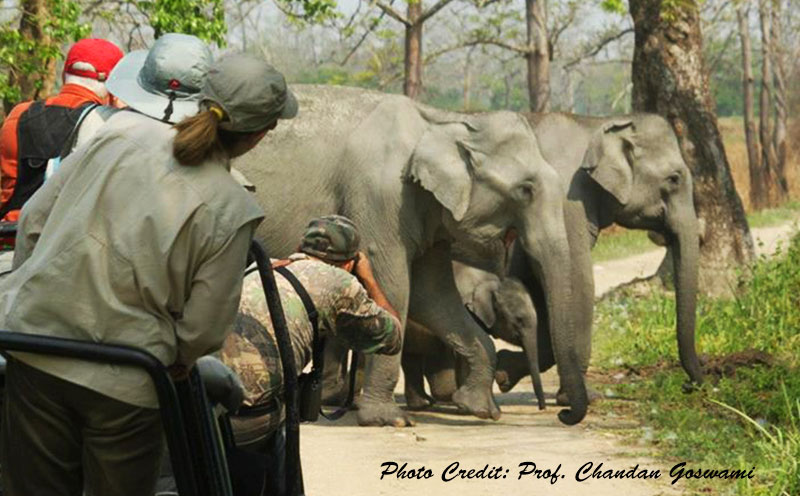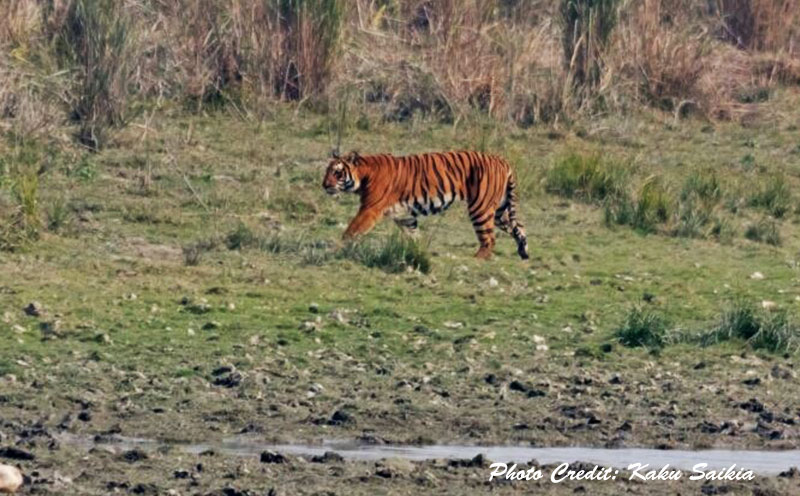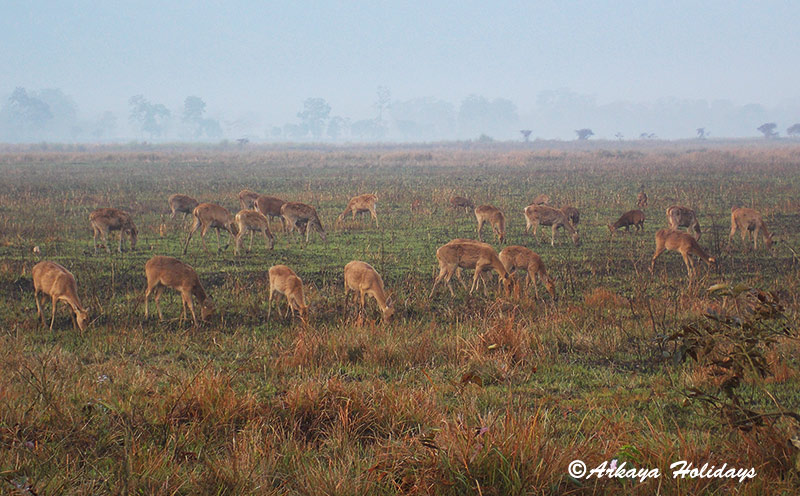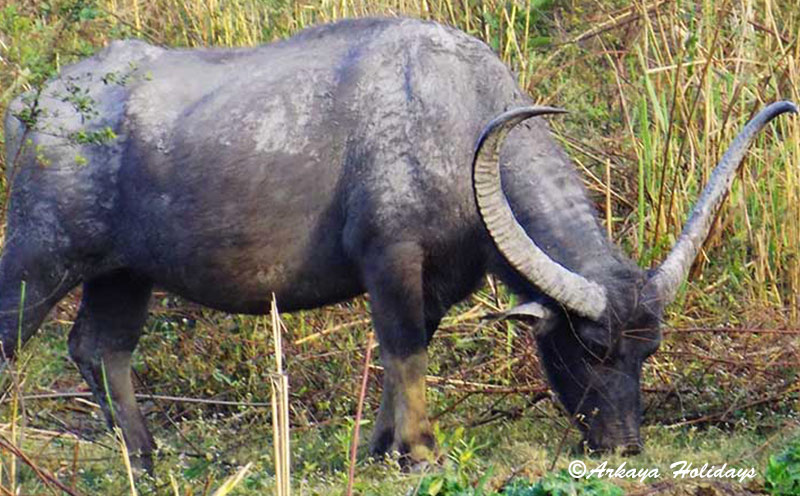
Here we provide a brief introduction of a few animals which are famous tourist attraction in kaziranga. The answer for kaziranga national park is famous for which animal is Great Indian one-horned Rhinoceros, that we simply refer to as One-horned Rhino. In the last population census held in 2015, the authority found 2401 numbers of the main attraction in kaziranga national park i.e, One-horned rhinoceros. The Kaziranga National Park attractions are:
The one-horned Rhinoceros (Rhinoceros Unicornis) found in Kaziranga National Park is famously known as Great Indian one-horned Rhinoceros and Asian one-horned Rhinoceros. It belongs to the ‘Rhinocerotidae’ family. Among the common native mammals found in Asia, Indian Rhinoceros is the second largest herbivorous animal in size next to the Indian Elephant.
Indian Rhino lives in densely vegetated sub-tropical forests. It consumes buds, flowers, fruits, berries, leaves and roots. Generally, full grown male Rhinos weigh around 2 to 2.5 tons while female Rhinos weigh approximately 1.6 tons. The average height of an Indian Rhino is 5 & ½ feet with a girth of 11 feet. The Indian Rhino has a single horn present in both males and females. It uses its horn for intimidation, defense, digging up roots and breaking branches of trees. The horn of Indian Rhino is made of Keratin. Hence, it is very strong. The average length of the horn is 25 cm.

Indian Rhino is a solitary mammal. It accompanies its female counterpart only at the time of mating. Breeding takes place at anytime throughout the year. The gestation period is about 1 year 4 months. Indian Rhino can run at the speed of 55 km per hour for a short while. It is also an excellent swimmer. Indian Rhino has relatively poor eye-sight. Yet, it has a strong sense of hearing and smell. The average life-span of an Indian Rhino is 47 years.
Listed as an endangered species, Indian Rhino has been pushed to a small fraction by poachers and deforestation. WWF- India, the Forest Dept. of Assam and several NGOs including Aaranyak have been working together over the years for implementing conservation programmes to protect Indian Rhino from being extinct.
Indian Elephant (Elephas maximus indicus) is the second largest existing mammal in this planet after Blue Whale. It is one of the three familiar sub-species of Asian elephant. Indian elephant belongs to ‘elephantidae’ family. As compared to African elephants, Indian elephants are smaller in size having smaller ears, broader skulls, larger trunks, more rounded back and forth toenail on each of their back feet. Indian elephant possesses the highest body point on its head.
An Indian elephant weighs between 2 tons to 5 tons. It grows to a length of maximum 20 feet and a shoulder height of 8 feet to 11 feet. Their skin is dark grey to brown with smaller patches of deep pigmentation. The highest shoulder height of the largest Indian elephant recorded till date is 11.3 feet. Elephant trunk has more than 40,000 muscles. The tip of the trunk is shaped like two-fingers which enables it to perform both weak movements and robust household tasks without difficulty. The back of Indian elephant is convex shaped. Indian Elephants have long, rough body hairs lightly covering their body.
Elephant is a mega-herbivorous animal consuming up to 150 kilograms of plant-life every day. It can consume 50 gallons of water in a day. Both the qualities of grazing and browsing make it easier for the elephant to find food in the jungle. It lives mainly on grass, plant-leaves, roots, barks, creepers and palms. Elephant also eats seasonal food like fig leaves and fruits, elephant-apple and mango. It grazes on tall grasses. It eats seedlings, culms and lateral shoot of bamboo grass.

Indian elephant is a social animal. It follows matriarchal type of family. It forms small groups of maximum 20 members including 6 - 7 female elephants. The smaller groups join to form herds. Sometimes a herd consists of more than 100 members, but such association is ephemeral. The eldest and often largest female elephant leads the herd. Tuskers may be associated with a herd. But, naturally they prefer to lead solitary lives. Elephants live an average life-span of 70 years. In favourable habitat conditions, a female elephant gives birth to a calf within 30 to 48 months. Otherwise, it takes every 5 to 8 years. After birth, a calf weighs 50 to 150 kilograms.
Since time immemorial, the elephant has been a key element of Indian culture. Elephant is domesticated and employed for transportation and carrying heavy objects from one place to another. Nowadays, elephant population is recognized as endangered species on earth by IUCN Red List due to deforestation, habitat degradation & fragmentation, poaching for precious ivory tusk, human-elephant conflict etc. Project Elephant, a Central Govt. of India sponsored scheme launched in 1992, has been successfully implemented to provide financial and technical support to major elephant populated states in India for protection of elephants, their habitats and migration corridors.
Royal Bengal Tiger (Panthera tigris) is popularly known as Indian tiger. The tiger is the largest and most ferocious predator of the cat family. It is renowned for its indisputable power and strength. It belongs to ‘Felidae’ family. Royal Bengal Tiger is the national animal of both India and Bangladesh.
Tiger is a carnivorous animal. It is a potent nocturnal killer. It can cover a long distance searching for its prey whether it may be a water Buffalo, a Swamp deer, a Sambar deer, a Gaur, a wild Pig, a Serow, a Takin or any other large mammal. The body of a mature Royal Bengal Tiger grows to a length of 9 - 10 feet, while the body of a mature tigress gets developed to 8 – 8 & ½ feet long. Tigers grow to an average height of 3 to 3 & ½ feet at the shoulders. The average weight of a mature Tiger is 2.2 quintals while that of a tigress is 1.4 quintals. The coat of the tiger is a unique feature of its body. No two tigers in the world possess exactly the same stripes.

Tigers in India do not have any particular mating and birth season. Tigers reach sexual maturity at an age of 4–5 years while tigresses receive the same at 3–4 years. A tigress comes into heat of mating at an interval of about 21 to 63 days and is receptive for 3 to 6 days. After a gestation period of 3 months & 2 weeks, a tigress delivers 2 to 5 cubs in either a cave or any safe shelter located near tall grass and thick bush. Newborn cubs weigh between 0.750 to 1.6 kilograms. Till attainment of 2 - 3 years of age, cubs stay close to their mother forming a small family. Within this period, young ones learn the skill of hunting from their mother. Subsequently, they start staying separately from the family and search for an area. Tiger is by nature, a solitary and territorial animal. An adult Royal Bengal Tiger covers a territory of two to seven tigresses. Once the family gets divided, the tigress comes into heat of mating again.
Royal Bengal Tiger is well known to devour other predators like leopards, wolves, jackals, foxes, crocodiles, Asiatic black bears and sloth bears as prey, even though they are not a part of its regular diet. Adult elephants and one horned rhinoceroses are too large to be hunted by tigers, but such unlikely events are not unprecedented. Most tigers avoid human beings. Nevertheless, man-eaters are fiercely dangerous.
Over the last century, deforestation and hunting of Tigers have diminished their total population in the world to a meager figure of 2500 or less. Unfortunately, all 5 sub-species of this majestic cat are recorded as endangered species living on Earth according to IUCN Red List. An ambitious conservation scheme, namely Project Tiger has been implemented successfully in Tiger Reserves of Indian sub-continent from its inception in 1973 - 74. It is a centrally sponsored scheme of Government of India. Project Tiger aims at maintaining a possible tiger population in the natural environment.
Swamp Deer (Cervus duvauceli) is popularly known as Barasingha in India. It is popular among animal lovers for its extremely large antlers found in adult stags. The antlers often grow to more than 12 tines. So ‘Barasingha’ is its name in Hindi language, meaning ‘twelve-tined’ Deer. Some mature adult Swamp Deer unusually possesses 18 - 20 tines. Swamp Deer belongs to the ‘Cervidae’ family. It is a vulnerable species of deer according to IUCN Red list of Indian mammals. An approximate population of 5000 Swamp Deer survives in this planet. Among the three sub-species of Swamp Deer found in India, Eastern Swamp Deer is found in Assam only. According to 2007 Census Report, only 681 Eastern Swamp Deer were found in Kaziranga National Park.
Swamp Deer is a large deer. It has wooly and yellowish brown hair in the upper body and pale coloured hair in the lower part with white spots along the spine. The hair in throat, belly and interior portions of the thighs is white coloured. The neck is manned. Males are darker than females. The coat colour of male Swamp Deer becomes darker during mating season. It grows to a height of 4 feet or more and body length of nearly 6 feet. Average stag weigh 175 kilograms while average doe weigh 140 kilograms. The antlers of an adult stag measures 2 & ½ feet round the curve with a girth of 5 inch at mid beam.

Being a herbivorous animal, Swamp Deer graze in herds. They prefer marshland to eat grass & aquatic plants. They stay close to water bodies to drink abundant water for the whole day long. Generally, a herd consist of 8 – 20 members. The number of doe in a herd is twice than stags. The breeding season of Swamp Deer starts from September to April. Fawn takes birth after a gestation period of 8 months in August to November. Doe gives birth to a single fawn at a time. A fawn attains the age of maturity in 2 years. Swamp Deer lives a maximum life span of 23 years.
Deforestation, poaching for antlers, conversion of swamp lands into farming fields and infectious diseases spread by domestic cattle has resulted in declination of Swamp Deer population in India.
Wild water buffalo (Bubalus arnee) is also known as Asiatic water buffalo. It is the largest member of the Bovini tribe, among yak, bison, African buffalo etc. Wild water buffalo belongs to the ‘Bovidae’ family.
Wild water buffaloes with gray-black coats are larger in size and heavier in weight than domestic buffaloes. They weigh between 7 to 12 quintals. Their head-to-body length is 8 to 10 feet. A mature wild water buffalo grows up to a shoulder height of 5 to 6 feet. Horns are common to both males and females. Yet, female horns are significantly smaller than that of males. Buffalo horns are heavy at the base and widely spread up to 6 feet along the outer edges. The loutish and thin hair is directed forward from the haunches to the head. It has a tuft on the forehead. The ears of a wild water buffalo are relatively small. The tip of the tail is shaggy; the hooves are large and splayed.
Wild water buffalo is a herbivorous mammal. Being a grazer by preference, it consumes grass and herbs of grasslands. Yet, they spend much of their day-time in wet lands of the tropical forest. Due to wide-splayed hoofed feet, wild water buffaloes do not sink deeply in the mud of wet lands and can move easily from marshes to marshes. They also browse on trees and shrubs. They also eat crops like rice, sugarcane and jute. Wild water buffaloes play a vital role in plant rejuvenation in the grassland ecosystem.

Wild water buffaloes are seasonal breeders. Though some buffaloes out of the entire population, breed round the year, yet most of them breed normally in the months of October and November. Dominant male buffaloes of a herd mate with the females which consequently pull towards them most. The gestation period of water buffalo is 9 to 11 months, with a birth interval of 1 year in between. Normally, they deliver a single calf, yet twin offspring are not unlikely. Sexual maturity is received by the males at the age of 1 & ½ years while females receive the same after completing 3 years. Wild water buffaloes live a life-span of maximum 25 years in the wild.
Adult female wild water buffaloes along with their calves form a fixed clan consisting of a maximum number of 30 members. Such a clan creates a home for resting, grazing, wallowing and drinking, ranging an area of 1.7 to 10 sq. kilometers. Old females lead such clans. Male buffaloes only accompany the clan. Many clans meet together at resting areas to form a herd of hundreds of members. Adult male buffaloes also form small bachelor groups consisting of maximum 10 members. Elder male buffaloes are often solitary and spend much of their time maintaining a safe distance from the other clans.
The total population of wild water buffaloes has established it as an endangered species according to IUCN Red List of Indian mammals. Being a preferable prey to tigers, cross-breeding with domestic buffaloes and deforestation leading to the destruction of suitable habitat have been considered as major threats to the wild water buffalo's survival in the jungle.
The forests of North-East India are well known among the nature lovers of the globe for the presence of rich floral and faunal bio-diversity. These virgin forests provide shelter to 9 out of 15 species of primates found in India. The hoolock gibbons (Hoolock) are one of the chief attractions of Kaziranga National Park.
Hoolock gibbons are popularly known as Langurs. There are two primate species from the family of the gibbons. Hoolock gibbons are the second largest primate species of the gibbons after the Siamang. A mature hoolock gibbon grows up to a size of 2 & ½ feet to 3 feet and weighs 7 to 10 kilograms. Both male and female hoolock gibbons acquire the same body-size, yet they differ in colours. Male gibbons have white brows with black coloured fur in the body while females have grey-brown body-hair with darker fur in chest and neck. The face of a hoolock gibbon looks like a mask due to the presence of white rings around it's eyes and mouth.
Hoolock gibbons live together in monogamous pairs. They live on fruits, insects and leaves. The gestation period of hoolock gibbons is 7 months. The body-hair colour of hoolock gibbon changes with attaining maturity. The fur of a young gibbon remains milky white. After six months of birth, the fur turns black. It takes 8 to 9 years for a young gibbon to become fully mature along with receiving final colour of body-hair. They live an average life-span of 25 years in the wild.